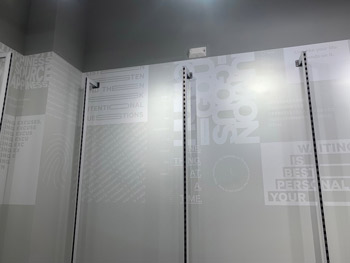When it comes to sign and graphic installation estimates, the phrases “You can never ask too many questions” and “A picture is worth a thousand words” could not be more relevant. As an “installation-only” company, it is up to us to do our due diligence to gather all of the pertinent information for a project from the graphic producer before submitting an installation quote. Failure to do so can negatively impact our team’s morale and our company's bottom line.
Photos of every element/angle of the project are a must. Be it a vehicle with aftermarket accessories or a building that you are going to have to determine what type of aerial lift equipment will be needed, you can never have too many photos of the project you are quoting.
Some examples of other items we request from our clients when we receive a Request for Quote (RFQ) for commercial vehicle wraps are the years, makes, and models — including wheelbases, roof types, cab types, and lists of any aftermarket accessories — of and on the vehicles. And we always ask what materials will be used for the project (including the laminate). I hear a lot of installers discussing this after the fact, saying “I was hired to wrap this car last week and my client used an inferior material that was extremely difficult to install.” This should be established before a quote is submitted so that you are not only educated on what it is you will be installing, but so that you price the project appropriately.
For example, we charge more for any installations where the vinyl is laminated with a liquid laminate verses a hard laminate because it affects the material's user-friendliness and ultimately the installation time. And finally, ask if the project will be performed in a temperature-controlled facility. Some of our clients do not have a facility and ask that we install outdoors, in which case all installation warranties are null and void due to wind, dust, sun, etc.
An important aside that is crucial for the protection of your installation company is to always use pre-inspection forms, noting any damage or defects. Take photos of the noted areas and have the end customer sign off on it before performing the installation. PdfFiller has a generic pre-inspection template that you can customize to your needs.
Some examples of the information and items we request for retail sign and graphic RFQs are:
–Materials being used
–Substrates they will be installed on/in (it is never fun showing up to hang a sign presumably on drywall and realizing it’s a concrete wall you’ll be drilling into)
–Photos and a list of all obstructions (outlets, fire extinguishers, shelving, etc)
–Special equipment (if any) that will be needed (e.g. aerial lift equipment, safety equipment, specialty drills and tools)
–Whether any necessary hardware will be supplied or will we supply it
 We also always ask if it will be during or before/after business hours as we charge more for the latter. Here is a photo example of a fairly involved die-cut lettering project with many obstructions. Had we just quoted based off of the client’s initial request of “2,000 sq. ft of die-cut vinyl installed on flat drywall at ladder height,” our pricing would have been drastically lower than the price we actually quoted once we received the photos of all the obstructions.
We also always ask if it will be during or before/after business hours as we charge more for the latter. Here is a photo example of a fairly involved die-cut lettering project with many obstructions. Had we just quoted based off of the client’s initial request of “2,000 sq. ft of die-cut vinyl installed on flat drywall at ladder height,” our pricing would have been drastically lower than the price we actually quoted once we received the photos of all the obstructions. Stay tuned for Part 2 of this topic that will cover more installation estimation tips, how to set parameters, and quoting installation removals.
 Ken Burns is the President/CEO of Axis Graphic Installations. A Boston native, Burns studied Business Management in the mid 90s and has consulted, developed, and managed multiple Fortune 500 companies. In 2006, he left his career to pursue the art of installing vehicle wraps. He saw the value of this niche industry and decided to bring his knowledge of large corporate structure to a newer industry that mostly comprised independent subcontractors. Burns started his first installation team in South Florida in 2009 and has since developed teams in Texas, Georgia, North Carolina, Maryland, and Pennsylvania. Beyond vehicle wraps, he and his teams have become proficient in all types of sign and graphic installations.
Ken Burns is the President/CEO of Axis Graphic Installations. A Boston native, Burns studied Business Management in the mid 90s and has consulted, developed, and managed multiple Fortune 500 companies. In 2006, he left his career to pursue the art of installing vehicle wraps. He saw the value of this niche industry and decided to bring his knowledge of large corporate structure to a newer industry that mostly comprised independent subcontractors. Burns started his first installation team in South Florida in 2009 and has since developed teams in Texas, Georgia, North Carolina, Maryland, and Pennsylvania. Beyond vehicle wraps, he and his teams have become proficient in all types of sign and graphic installations.